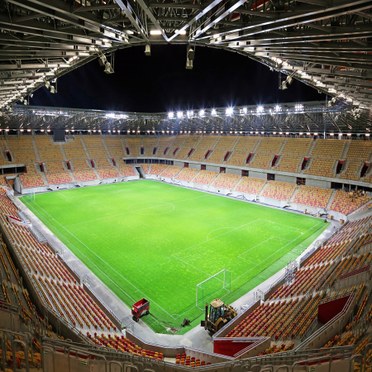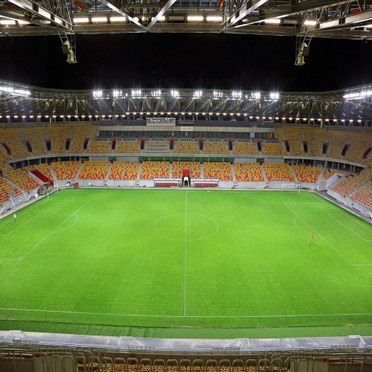Białystok City Stadium, Poland
- Lamp efficacy
Lamp efficacy
Ensuring the lamp efficiently converts electricity into light (lm/W).
- Ballast classification
Ballast classification
Controlling the electricity supply to the lamp (Energy Efficiency Index).
- Luminaire distribution
Luminaire distribution
Precise optical control of the metal halide lamp within the Mundial floodlight offers just the right light onto the playing area with a gentle run off onto the first rows of spectators
- System efficacy
System efficacy
Combining optical and thermal control within the luminaire (luminaire lm/W).
- Presence/absence detection
Presence/absence detection
Presence: Lights automatically turn on/off with movement. Absence: Lights automatically turn off and must be manually switched on.
- Daylight detection
Daylight detection
Artificial lighting which responds to the natural light conditions.
- Constant illuminance
Constant illuminance
A function designed to produce correct light levels for the duration of the maintenance period.
- Task-scene setting
Task-scene setting
Allowing the user to set scenes and adapt the lighting to different tasks.
- Timed off
Timed off
Automatic cut-off can be installed to turn all lights off during unoccupied hours.
- Task lighting
Task lighting
Lighting task areas with the correct amount of light.
- Zoning of lighting
Zoning of lighting
Lighting is zoned according to area use.
- Maintenance schedule
Maintenance schedule
Correct and timely maintenance of the floodlights ensures not only efficient operation, but UEFA certification.
- Waste light
Waste light
Tight control of obtrusive light ensures the surrounding buildings and environment are not affected by the stadium’s activities.
- Reflectance
Reflectance
Taking advantage of light which is reflected from the surface within the space.
- Visible smart metering
Visible smart metering
Results of actions can be quickly seen as increased or decreased energy use to encourage responsible energy consumption.
Białystok City Stadium in Poland was first opened in 1971 and is used by the top division Jagiellonia football club. It has recently undergone a major redevelopment including an increase in the seating capacity from 7,500 to 22,409 and the provision of new lighting.
With the previous lighting installation not exceeding 1000 lux, the first objective was to improve the lighting to enable high definition sports TV broadcasting. The second objective was to increase the illuminance level to comply with UEFA and Polish Football Association requirements, in order to be granted a playing license.
Thorn was awarded the contract to refurbish the pitch and stand lighting using its Mundial floodlight and Titus Industry luminaire. Mundial 2000W HQI-TS provides the pitch lighting and is a high power and performance floodlight specifically designed for sports applications. It was chosen on the basis of its ability to achieve the required light levels of 3000 lux with just 240 floodlights. Using two optics (S/S and R/S), a circular reflector with symmetric distribution is used for the long-throw application while a baffle is used to achieve symmetrical light distribution with low glare and minimal spill and upward light.
For the stand lighting, Titus Industry T16 (T5) 4x80W and 2x80W offers a robust solution while providing a comfortable environment for spectators with mounting brackets which allow stepless tilting up to 50°.
Results and benefits
The installation was executed while the stadium was operational and partially during the football season. It was therefore phased to minimise disruption. Marek Rychlik, Head of the Lighting Design Department at Thorn says: “Lighting of the pitch complies to the highest standards as usual for Thorn while the lighting of the stand is extremely comfortable for people watching the game.”
- Bialystok stadium Case study.pdf
(PDF/
907 KB)
Please click to download the brochure as a pdf.


